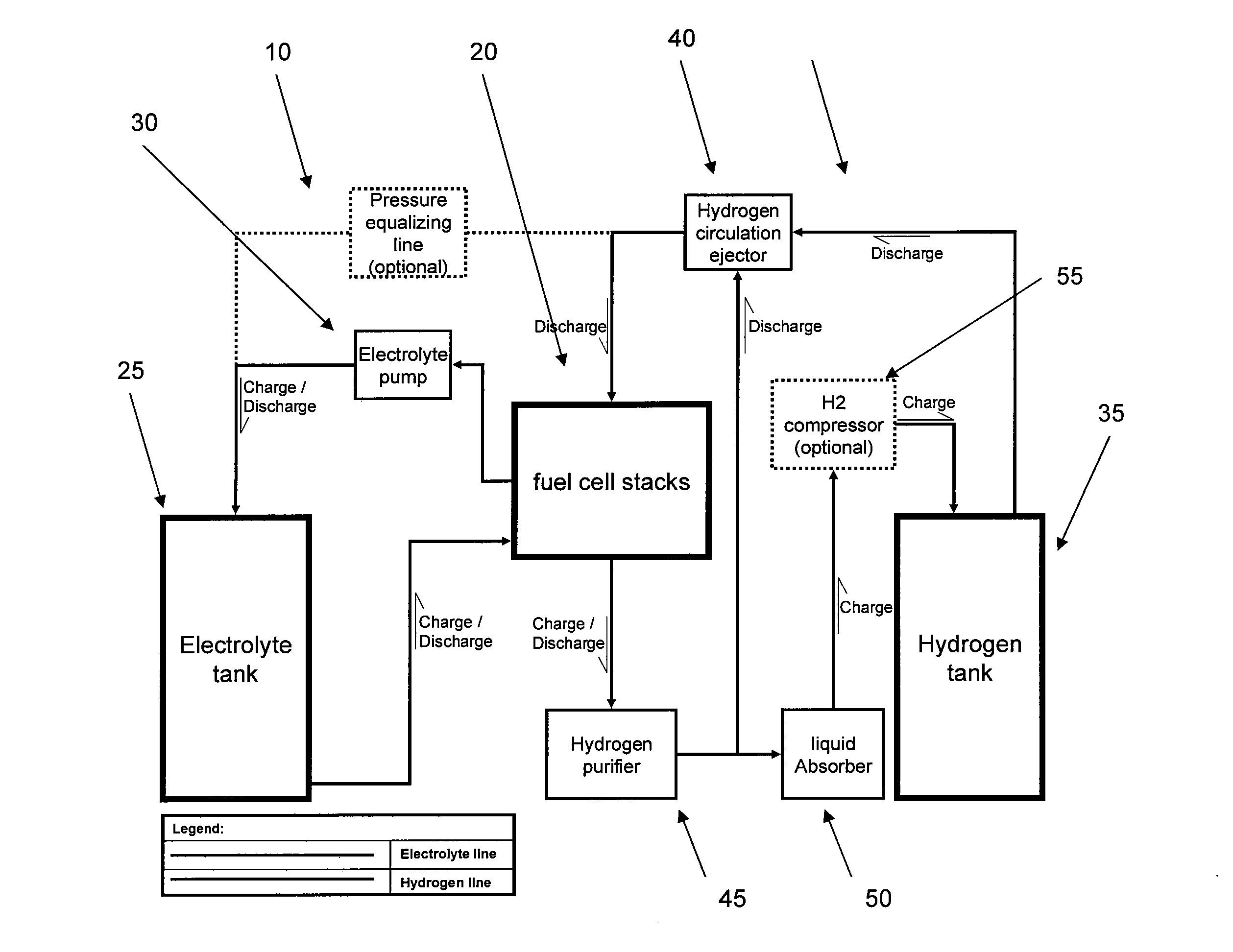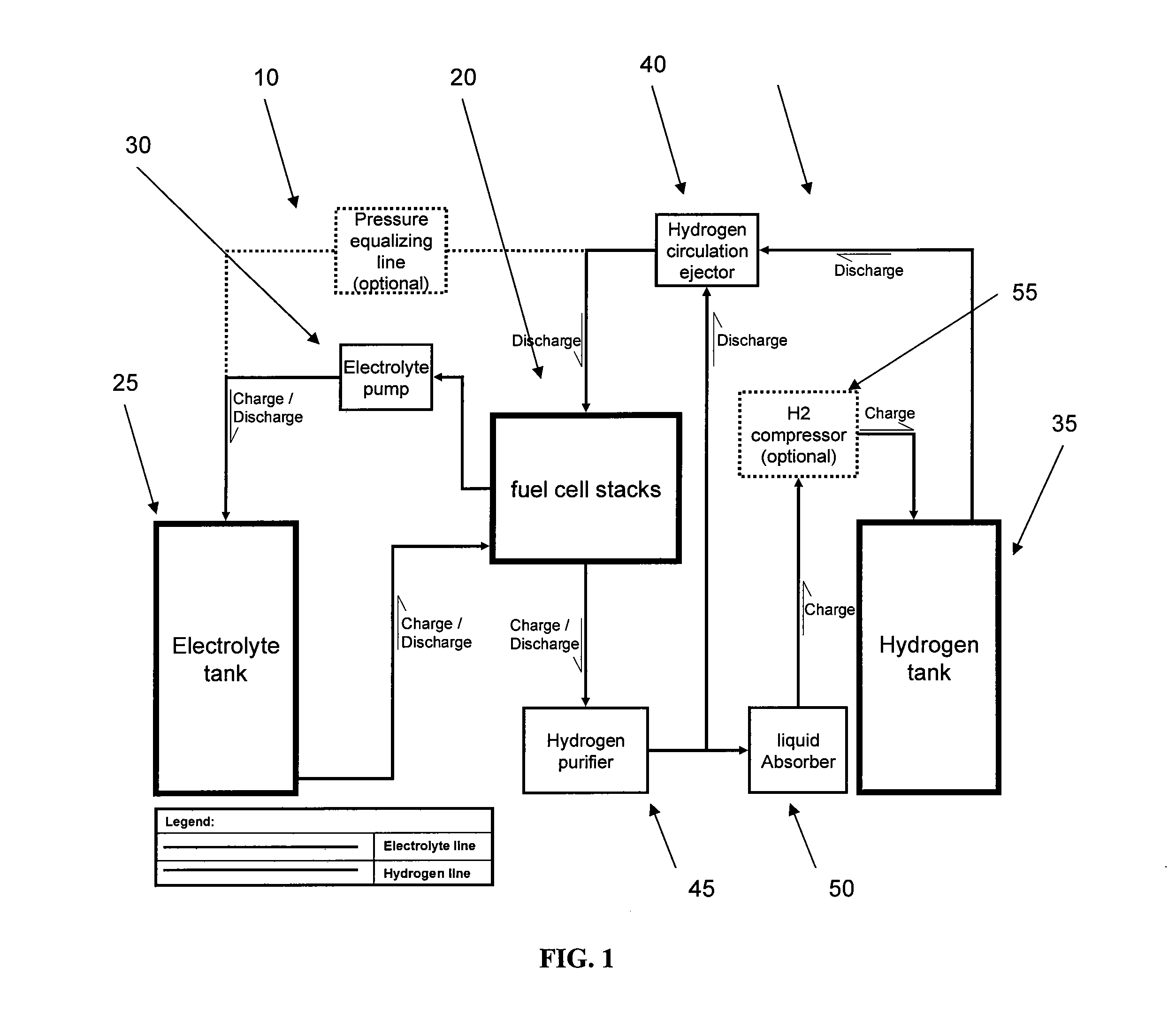Energy storage and generation systems
a technology of energy storage and generation system, applied in the direction of cell components, sustainable manufacturing/processing, final product manufacturing, etc., can solve the problems of limited capacity (total energy), limited power density and response time of flow batteries, and high cost or inefficiency of current electrochemical storage and generation technology, etc., to achieve fast response time, low cost, and acceptable life and performance
- Summary
- Abstract
- Description
- Claims
- Application Information
AI Technical Summary
Benefits of technology
Problems solved by technology
Method used
Image
Examples
example 1
Preparation of Hydrophobic Silica Beads Coated with Reactive Catalyst for Corrosive Vapor Elimination
[0147]30 grams of ⅛″ diameter silica beads with low surface area of 0.11 m2 / g were placed in oven for 1 hour at 100° C. for moisture removal. The resulting product was placed in a beaker. A 16.5 ml volumetric 1:1 solution of 60 wt % polytetrafluoroethylene (PTFE) and water was mixed until it was fully homogenized. The resulting solution was used to soak the dry silica by the incipient wetness method. The product was them placed in oven for liquid removal and PTFE curing for 15 minutes at 350° C. The final PTFE weight addition was measured to be 19%. The hydrophobic silica beads were then incipient wetted with a catalyst ink prepared from known ratios of isopropyl alcohol, tetra butyl ammonium hydroxide, per-fluoro ionic polymer and oxidation catalyst. The catalyst weight percent was calculated to be 0.5% of the total silica weight. The finished product was cured in oven for 1 hour at...
example 2
Reaction Between Bromine (Br2) and Excess Hydrogen (H2) at the Outlet of the Fuel Cell Stack
[0148]The reaction is depicted as follows: H2+Br2=2HBR ΔHf=−36.29 kJ / mol. This reaction takes place in the presence of a catalyst embedded on the surface of supporting beads. The HBr formed in the exothermic reaction is removed from the reactor by the remaining hydrogen stream in form of droplets or vapors.
example 3
Removal of Bromine from Hydrogen Rich Bromine Vapor
[0149]Referring to FIG. 5, dry hydrogen supplied from cylinder 10 was passed through flow meter 15, and into a bromine vapor rich tube device 20 having a temperature that varied from ambient to 45° C. The hydrogen rich bromine vapor then passed into another glass tube 25, with known amount of catalyst supported on hydrophobic silica beads. The reacted hydrogen was then bubbled in a water cylinder 30. The residence time of the gas passing through the catalyst was 1 second. The bromine content in the gas stream before entering the reaction tube was 10,000 ppmwt. The outlet stream bromine content was also tested and measured to be below 4 ppmwt (4 ppmwt is the measuring device lower limit). The experiment lasted for 3 months. During the experiment, total bromine weight of more than 2 times was treated by the catalyst. This is an indication that the bromine was not adsorbed but rather reacted on the catalyst.
PUM
| Property | Measurement | Unit |
|---|---|---|
| size | aaaaa | aaaaa |
| proton conducting | aaaaa | aaaaa |
| acid absorption capacity | aaaaa | aaaaa |
Abstract
Description
Claims
Application Information
 Login to View More
Login to View More - R&D
- Intellectual Property
- Life Sciences
- Materials
- Tech Scout
- Unparalleled Data Quality
- Higher Quality Content
- 60% Fewer Hallucinations
Browse by: Latest US Patents, China's latest patents, Technical Efficacy Thesaurus, Application Domain, Technology Topic, Popular Technical Reports.
© 2025 PatSnap. All rights reserved.Legal|Privacy policy|Modern Slavery Act Transparency Statement|Sitemap|About US| Contact US: help@patsnap.com



